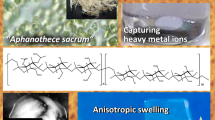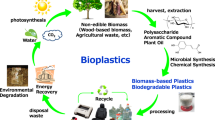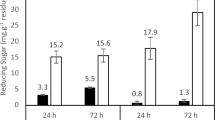Abstract
In recent years, significant progress has been made in discovering and developing new bacterial polysaccharides that possess novel and highly functional properties. For example, the relationship between the unique properties of xanthan gum—the first microbial polysaccharide of commercial significance—and its use in major food, industrial, and oil field applications is discussed. In addition, gellan gum, the extracellular polysaccharide produced by Pseudomonas elodea, can be used in microbiological media and in gelled and structured food products. Three other industrially useful bacterial polysaccharides have been developed. S–130, the extracellular, high viscosity polysaccharide produced by a strain of Alcaligenes, has excellent suspending and heat stability properties useful in oil field drilling, workover and completion, and enhanced oil recovery fluids. S–194 has excellent suspending properties and unusual compatibility with salts, making it useful in agricultural applications, particularly flowable pesticides and liquid fertilizers. S–198 has excellent stability to shear and has potential application in the developing market of water–based lubricants.
This is a preview of subscription content, access via your institution
Access options
Subscribe to this journal
Receive 12 print issues and online access
$209.00 per year
only $17.42 per issue
Buy this article
- Purchase on Springer Link
- Instant access to full article PDF
Prices may be subject to local taxes which are calculated during checkout
Similar content being viewed by others
References
McNeely, W.H. and Kang, K.S. 1973. Xanthan and Some Other Biosynthetic Gums, p. 473–497. In: Industrial Gums, 2nd Ed., R. L. Whistler and J. N. BeMiller (eds.) Academic Press, New York.
Cottrell, I.W. and Kang, K.S. 1978. Xanthan gum, a unique bacterial polysaccharide for food applications. Dev. Ind. Microbiol. 19: 117–131.
Lawson, M.A. and Fitzgerald, E.E. Unpublished data.
Pettitt, D.J. unpublished data.
Jansson, P.E., Kenne, L. and Lindberg, B. 1975. Structure of the extracellular polysaccharide from Xanthamunas campestris. Carb. Res. 45: 275–282.
Melton, L.D., Mindt, L., Rees, D.A. and Sanderson, G.R. 1976. Covalent structure of the extracellular polysaccharide from Xanthomonas campestris: evidence from partial hydrolysis studies. Carb. Res. 46: 245–257.
Moorhouse, R., Walkinshaw, M.D. and Arnott, S. 1977. Xanthan gum—molecular conformation and interactions. Am. Chem. Soc. Symp. Ser. 45: 90–102.
Rinaudo, M. and Milas, M. 1982. Xanthan properties in aqueous solution. Carb. Polymers. 2: 264–269.
Frangou, S.A., Morris, E.R., Rees, D.A., Richardson, R.K. and Ross-Murphy, S.B. 1982. Molecular origin of xanthan solution rheology: effect of urea on chain conformation and interactions. J. Polymer Sci. Polymer Letters Edition. 20: 531–538.
Kang, K.S. and Veeder, G.T. 1983. Fermentation Process for its Preparation of Polysaccharide S-60. U.S. Pat. 4,377,636.
Kang, K. S. and Veeder, G.T. 1982. Polysaccharide S-60 and Bacterial Fermentation Process for its Preparation. U.S. Pat. 4,326,053.
Kang, K.S., Colegrove, G.T. and Veeder, G.T. 1982. Deacetylated Polysaccharide S-60. U.S. Pat. 4,326,052.
Browning, B.L. 1967. Uronic Acids: Determination by Decarboxylation. Methods of Wood Chemistry. 2: 632–637.
Bitter, T. and Muir, H.M. 1962. A Modified Uronic Acid Carbazole Reaction. Anal. Biochem. 4: 330–334.
Kosakai, M. and Yosizawa, Z. 1975. A Partial Modification of the Carbazole Method of Bitter and Muir for Quantitation of Hexuronic Acids. Anal. Biochem. 69: 415–19.
Hestrin, S.J. 1949. The reaction of acetylcholine and other carboxylic acid derivatives with hydroxylarnine, and its analytical application. J. Biol. Chem. 180: 249–261.
Jansson, P.-E., Lindberg, B. and Sandford, P. A. 1983. unpublished data.
O'Neill, M.A., Sclvendran, R.R. and Morris, V.J. unpublished data.
Moorhouse, R., Colegrove, G.T., Sandford, P.A., Baird, J.K. and Kang, K.S. 1981. PS-60: a new gel-forming polysaccharide. Am. Chem. Soc. Symp. Ser. 150: 111–124.
Veeder, G.T., Cottrell, I.W. and Kang, K.S. unpublished data.
Shungu, D. 1983. unpublished data.
Anon. 1983. Fermentation yields a new gum. Food Engineering. 55: 52–53.
Sanderson, G.R. 1981. Polysaccharides in foods. Food Technol. 35: 50–57, 83.
Kang, K.S. and Veeder, G.T. 1982. Heteropolysaccharide S-130. U.S. Pat. 4,342,866.
Author information
Authors and Affiliations
Rights and permissions
About this article
Cite this article
Baird, J., Sandford, P. & Cottrell, I. Industrial Applications of Some New Microbial Polysaccharides. Nat Biotechnol 1, 778–783 (1983). https://doi.org/10.1038/nbt1183-778
Issue Date:
DOI: https://doi.org/10.1038/nbt1183-778
This article is cited by
-
Dissection of exopolysaccharide biosynthesis in Kozakia baliensis
Microbial Cell Factories (2016)
-
Biosynthese und Genomik mikrobieller Polysaccharide
BIOspektrum (2014)
-
Partial purification and chemical characterization of a glycoprotein (putative hydrocolloid) emulsifier produced by a marine bacterium Antarctobacter
Applied Microbiology and Biotechnology (2007)
-
Sulfated exopolysaccharide production by the halophilic cyanobacterium Aphanocapsa halophytia
Current Microbiology (1995)
-
Xanthan gum produced from whey by a mutant strain ofxanthomonas campestris
Folia Microbiologica (1993)



